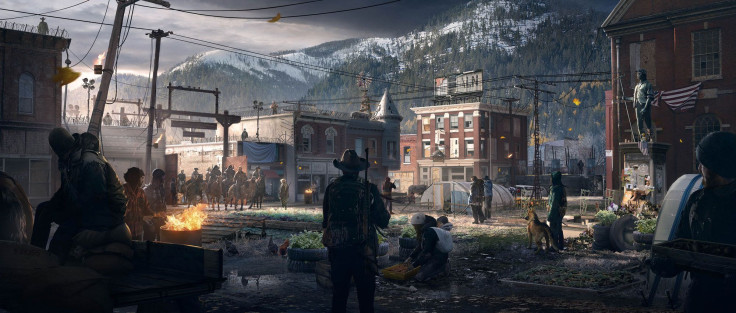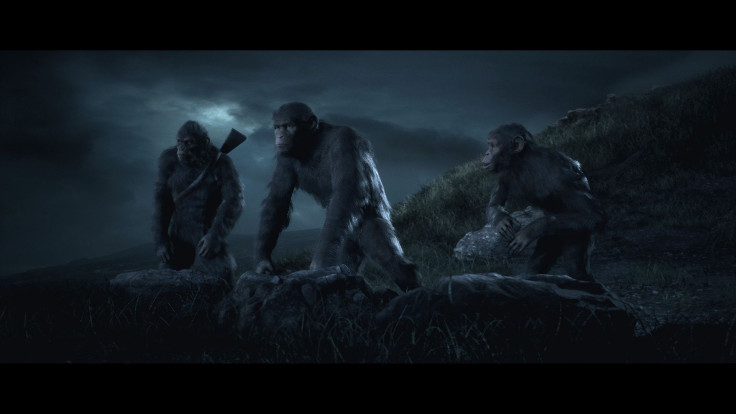After Caesar killed Koba in Dawn of the Planet of the Apes, ending Koba’s coup, ape society was fractured just when they needed unity most. War against the humans was imminent. Planet of the Apes: Last Frontier, an upcoming cinematic adventure game, follows apes who chose to leave behind Caesar and his conflicts. In the Rocky Mountains, as winter sets in, they find conflict of their own.
Imaginati Studios, an in-house developer at Andy Serkis’ performance capture shop The Imaginarium, wants Planet of the Apes: Last Frontier to blur the lines between movies and video games. Everything from the writing, through the production, to the gameplay work toward a hybrid form. Player.One spoke with Martin Alltimes, founder of Imaginati, about Planet of the Apes: Last Frontier’s approach to cinematic video game storytelling, which is coming to PC, PS4 and Xbox One this fall.
Last Frontier pits its faction of apes against a valley of farmers and ranch hands who have weathered the aftermath of the simian flu in a walled town — a Western fort that signals Last Frontier’s genre aspirations. Taking a step beyond the Western-flavored horseplay in War for the Planet of the Apes, Last Frontier feels like a radically different context for Planet of the Apes, full of cattle rustling and cowboy hats.

“There's a lot of exploration of Western themes reappropriated with post-apocalyptic twist. Classic moments that you would have seen in westerns I grew up with,” Alltimes said. Modern and 19th century technology intermingle, like pickup trucks with stagecoach rigging.
On one side of this conflict, players voice Bryn, a chimpanzee caught between his two brothers: the aggressive Tola, eager to purge their troop of weakness, and Juno, the exact variety of weakling Tola would expunge. There’s order with their father in charge, but it’s a dangerously divided house. Alltimes compared them to the Corleones of The Godfather movies.
The humans are similarly riven. Players make choices for Jess, the town’s leader, besieged on all sides by various interests, but especially by local landowner and upstart militia leader, Luke Rainey, who happens to control the town’s food supply. They don’t take too kindly to apes stealing their food.

If you’ve played a Telltale game, Last Frontier’s gameplay will be familiar (Alltimes also cites Heavy Rain as an influence): make choices at decisive moments in the narrative, building support from different factions within the ensemble cast and altering subsequent events.
“A lot of the characters can die in it and a lot of the reasons characters have to die is necessary. If you want peace, it doesn’t always involve everyone living.” Alltimes said. “The worst-case scenario, humans and the apes are annihilated. The best-case scenario, all the people who should survive, do survive. And there's everything in-between.”
In Last Frontier up to four players can vote on decisions. Some are severely time-constrained. Others might lead to a tie (every player can break a tie once, then wait until every other player has used the ability before breaking another).
But Last Frontier takes its cinematic hybridity even further than games like The Walking Dead. There are no puzzles or point-and-click adventuring.
“I think a lot of the time what happens with movie tie-ins, it’s like, crowbar in a platform mechanic, crowbar in a shooting mechanic, crowbar in a fighting mechanic and you have these characters who go through all kinds of moral dilemmas, but the reality is you’re just shooting things and you don’t really care,” Alltimes said.
Alltimes and Last Frontier External Producer Mark Inman demoed two different scenes for Player.One, the first involving a cattle theft gone wrong, the second an interrogation of a captured orangutan, conducted with baseball bats. Both were compelling scenarios, with clear stakes for the players deciding their way through the narrative, but in isolation it’s impossible to say if the pared back gameplay and feature-length runtime makes for a more cinematic experience.

Alltimes is aware of the stakes, setting a high standard for Last Frontier’s story. “All we’ve got is the narrative,” Alltimes said. “Either the stories are interesting and the characters are interesting, or they’re not.”
This focus on the story steered Planet of the Apes: Last Frontier from the beginning. After experimenting with a team of writers, similar to a TV writer’s room, Alltimes switched to something more akin to a movie screenwriting process with Last Frontier co-writers Neil Richards and Matt Costello. Both were pioneers in video game storytelling, writing for groundbreaking narrative games like The 7th Guest and Starship Titanic.
Director Steve Kniebihly previously did cutscenes for The Witcher 3 expansions (including series cap Blood and Wine) and the motion capture for Heavy Rain. The combination of Andy Serkis’ motion capture studio and the suite of lenses and cinematographic tools in Unreal Sequencer brought Last Frontier’s production more in-line with a movie shoot.
“We are a video game company, there's no two ways about that, but we're after as much of a director-writer-producer relationship as possible,” Alltimes said. “Motion capture is like nitroglycerin, it's an incredibly powerful tool, but you're not compromising because that's a real character you're capturing.”
Apes together strong. Apes with cowboy hats…

















![[EG April 19] Best 'Stardew Valley' Mods That Will Change](https://d.player.one/en/full/226012/eg-april-19-best-stardew-valley-mods-that-will-change.png?w=380&h=275&f=955520b8313253ee3c39c791f6210f38)
